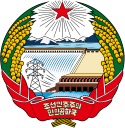- Elections in North Korea
-
North Korea 
This article is part of the series:
Politics and government of
North Korea
- Eternal President
- Supreme Leader
- Supreme People's Assembly
- Chairman of the Presidium
- National Defence Commission
- Chairman
- First Vice Chairman
- vacant
- Government
- Subdivisions
- Judiciary
- Political parties
- Elections: 2003, 2009
Elections in North Korea are held every five years. At the national level, North Koreans elect a legislature, the Supreme People's Assembly (SPA). In addition to the Supreme People's Assembly, the people elect representatives to city, county, and provincial "people's assemblies".[1][2]
All seats were won by the Democratic Front for the Reunification of the Fatherland.[3] The Workers' Party of Korea dominates the Front and held 87.5% of the seats, with 7.4% for the Korean Social Democratic Party, 3.2% for the Chondoist Chongu Party, and 1.9% for independent deputies.[4] According to official reports, turnout is near 100%, and approval of the Democratic Front's candidates is unanimous or nearly so.[1]
Contents
Procedure
In reply to a question put forth by Michael Marshall, Li Chun Sik of North Korea stated at a meeting of the Association of Secretaries General of Parliaments (ASGP) of the Inter-Parliamentary Union:[5]
“ While candidates could be nominated by anyone, it was the practice for all candidates to be nominated by the parties. These nominations were examined by the United Reunification Front and then by the Central Electoral Committee, which allocated candidates to seats. The candidate in each seat was then considered by the electors in meetings at the workplace or similar, and on election day the electors could then indicate approval or disapproval of the candidate on the ballot paper. ” Elections are ostensibly conducted by secret ballot, but only one candidate appears on the ballot.[6] A voter may cross off the candidate's name to vote against him, but must do so in a special booth without any secrecy. According to many North Korean defectors, such an act of defiance is too risky to even attempt.[6]
Members of the Supreme People's Assembly are elected to five-year terms, and meet for SPA sessions up to ten days per year.[1] The Supreme People's Assembly elects a standing committee known as the Presidium, which exercises legislative functions when the Assembly is not in session. It also elects the Chairman of the National Defence Commission, the country's chief executive, and the Premier.
Latest election
Main article: North Korean parliamentary election, 2009The latest election was held on March 8, 2009. The following day, North Korean media announced that Kim Jong-il was unanimously re-elected to parliament, though none of his sons were among the appointments.[7] The election committee also stated that 99.98% of all registered voters took part in voting, with 100% voting for their candidate in each district.[8] All seats were won by the Democratic Front for the Reunification of the Fatherland, under the control of the Worker's Party.[3]
Summary of the 8 March 2009 North Korea Supreme People's Assembly election results List Seats Democratic Front for the Reunification of the Fatherland
- Workers' Party of Korea (Chŏson Rodong-dang)
- Korean Social Democratic Party (Chŏson Sahoeminju-dang)
- Cheondoist Chongu Party (Ch'ŏndogyo Ch'ŏng'u-dang)
- General Association of Korean Residents in Japan (Ch'ongryŏn)
- independents
687
606
50
22
6
3Total (turnout 99.98%) 687 Source:[3][9] Past elections
Parliamentary elections Local elections 2007 · 2011See also
- Electoral calendar
- Electoral system
- List of Korea-related topics
- Politics of North Korea
- Sham election
References
- ^ a b "DPRK Holds Election of Local and National Assemblies". People's Korea. http://www1.korea-np.co.jp/pk/195th_issue/2003081602.htm. Retrieved June 28, 2008.
- ^ "The Parliamentary System of the Democratic People's Republic of Korea" (PDF). Constitutional and Parliamentary Information. Association of Secretaries General of Parliaments (ASGP) of the Inter-Parliamentary Union. p. 4. http://www.asgp.info/Resources/Data/Documents/CJOZSZTEPVVOCWJVUPPZVWPAPUOFGF.pdf. Retrieved October 1, 2010.
- ^ a b c Moon, Angela; Sugita Katyal, Ralph Boulton (2009-03-08). "N.Korea vote may point to Kim successor". Reuters. http://www.reuters.com/article/worldNews/idUSTRE5270FE20090308. Retrieved 2009-03-08.
- ^ "The Parliamentary System of the Democratic People's Republic of Korea" (PDF). Constitutional and Parliamentary Information. Association of Secretaries General of Parliaments (ASGP) of the Inter-Parliamentary Union. p. 5. http://www.asgp.info/Resources/Data/Documents/CJOZSZTEPVVOCWJVUPPZVWPAPUOFGF.pdf. Retrieved October 1, 2010.
- ^ "The Parliamentary System of the Democratic People's Republic of Korea" (PDF). Constitutional and Parliamentary Information. Association of Secretaries General of Parliaments (ASGP) of the Inter-Parliamentary Union. pp. 17–18. http://www.asgp.info/Resources/Data/Documents/CJOZSZTEPVVOCWJVUPPZVWPAPUOFGF.pdf. Retrieved October 1, 2010.
- ^ a b "North Korea votes for new rubber-stamp parliament". Associated Press. March 8, 2009.
- ^ "N Korea polls 'give no clue'". Press Association. March 9, 2009. http://www.google.com/hostednews/ukpress/article/ALeqM5gVL_gdWRVDpqqzTnFcHVvrg6Mznw.
- ^ "N Korea's Kim wins parliamentary seat: official media". AFP. March 9, 2009. http://www.google.com/hostednews/afp/article/ALeqM5gimZEj8zI99uCXzdaCqn_FoKT97A.
- ^ "IPU PARLINE Database: Choe Go In Min Hoe Ui". Inter-Parliamentary Union. http://www.ipu.org/parline/reports/2085_E.htm.
External links
Elections in Asia Sovereign
states- Afghanistan
- Armenia
- Azerbaijan
- Bahrain
- Bangladesh
- Bhutan
- Brunei
- Burma (Myanmar)
- Cambodia
- People's Republic of China
- Cyprus
- East Timor (Timor-Leste)
- Egypt
- Georgia
- India
- Indonesia
- Iran
- Iraq
- Israel
- Japan
- Jordan
- Kazakhstan
- North Korea
- South Korea
- Kuwait
- Kyrgyzstan
- Laos
- Lebanon
- Malaysia
- Maldives
- Mongolia
- Nepal
- Oman
- Pakistan
- Philippines
- Qatar
- Russia
- Saudi Arabia
- Singapore
- Sri Lanka
- Syria
- Tajikistan
- Thailand
- Turkey
- Turkmenistan
- United Arab Emirates
- Uzbekistan
- Vietnam
- Yemen
States with limited
recognition- Abkhazia
- Nagorno-Karabakh
- Northern Cyprus
- Palestine
- Republic of China (Taiwan)
- South Ossetia
Dependencies and
other territoriesCategories:
Wikimedia Foundation. 2010.
